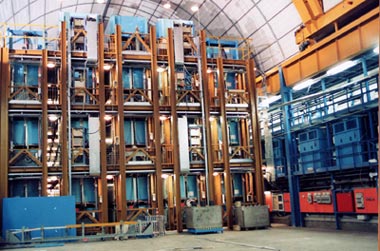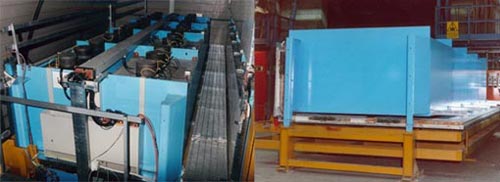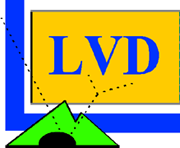
The basic element for neutrino detection is the liquid scintillation counter
consisting of an iron tank of dimensions (1.5 x 1.0 x 1.0) m3, filled
with white spirit (CnH2n+2 with a mean n value of 9.6
and density of 800 kg m-3), doped with appropriate scintillating
chemicals. Three photomultiplier tubes on the top of each counter watch the
scintillating liquid. 8 liquid scintillation counters are assembled in independent
modules: 35 of such modules, tightly arranged in five columns, constitute one
tower. The whole LVD apparatus, consisting of three 'towers', is thus characterized
by a very high modularity. The counters are set at different energy thresholds,
depending on their position with respect to the cavern walls: the external
ones (43% of the total), operate at threshold ˜ 7 MeV, while the inner
ones (57% of the total), better shielded from rock radioactivity operate at
4 MeV. All counters are then equipped with an additional discrimination channel,
set at a lower threshold, ˜ 1 MeV.
Table 1: main LVD characteristics.
|
Length
|
22.7 m
|
|
Width
|
13.2 m
|
|
Height
|
10. m
|
|
Steel mass (scint. containers and support structure)
|
1020 tons
|
|
Scintillator Volume
|
1260 m3
|
|
Scintillator Mass
|
1008 tons
|
|
Nb. of scintillator counters
|
840
|
|
Nb. of PMTs
|
2520
|
|
Nb. of L-shaped tracking modules
|
105
|
|
Nb. of limited streamer tubes
|
~ 9000
|
Concerning the detection principle, neutrinos can interact in the scintillator
either with the free hydrogen protons or with the carbon nuclei. More in detail,
the observable neutrino interactions are:
- Charged current reaction of electron antineutrinos on protons to form a
neutron and a positron
ve+p
-> n + e+
which is observed through a prompt signal from e+, followed by
the emission of a detectable g of 2.2 MeV due
to the neutron capture
n
+ p -> d + g
with a mean time delay of ˜ 180 ms.
- Charged current interactions of electron neutrinos and antineutrinos with
12C nuclei:
ve + 12C
-> 12B + e+
ve + 12C
-> 12N + e-
which are observed through two signals: the prompt one due to the e+ (e-)
followed by the signal from the b- (b+)
decay of 12B (12N), with mean life time 15.9 ms
(29.4 ms).
- Neutral current interactions of all neutrino (antineutrino) species with 12C
nuclei
vx + 12C
-> vx + 12C
+ g(15.1
MeV) ( x = e, m, t)
whose signature is the monochromatic photon from carbon de-excitation.
- Elastic scattering of neutrinos (antineutrinos) of all families on electrons
vx +
e- -> vx +
e-
which yields a single signal due to the recoil electron.
The LVD detector is furtherly equipped with a tracking system which consists
of L-shaped detectors for each 8-counters module. Every element contains two
staggered layers of 6.3 m long limited streamer tubes. The bidimensional read-out
is made by means of 4 cm strips, parallel and perpendicular to the tubes, providing
high detection efficiency and an angular resolution better than 4 mrad.

LVD physics
In spite of the lack of a ”standard” model of the gravitational
collapse of a massive star, some features of its dynamics and, in particular,
of the correlated neutrino emission appear to be well established. At the end
of its burning phase a massive star (M > 8 solar mass) explodes into a supernova,
originating a neutron star which cools emitting its binding energy ˜ 3
x 1053 erg mostly in neutrinos. The largest part of this energy,
almost equipartitioned among neutrino and antineutrino species, is emitted
in the cooling phase. The energy spectra are approximatively a Fermi-Dirac
distribution, but with different mean temperatures,
since ne, ne and nt have
different couplings (cross sections values) with the stellar matter: Tne < Tne < Tnx
Since the described features of stellar collapses are essentially common
to all existing models and lead to rather model independent expectations for
supernova neutrinos, the signal observable in LVD, in different reactions and
due to different kinds of neutrinos, besides providing astrophysical information
on the nature of the collapse, is sensitive to intrinsic n properties,
as oscillation of massive neutrinos.
LVD has been continuosly monitoring the whole Galaxy in the search for neutrino
bursts from gravitational stellar collapses since 1992. No stellar collapses
in our Galaxy have been detected so far.
LVD is involved in the SNEWS (Supernova Early Warning System), which is an
international collaboration including all of the current major supernova neutrino
detectors. The goal of SNEWS is to provide the astronomical community with
a prompt alert of the occurrence of a galactic core collapse event: the neutrino
signal indeed will emerge promptly from a supernova while it may take hours
for the first photons to be visible.
In addition to its major purpose, the LVD detector allows for other important
physics studies, mainly related to cosmic rays. The tracking system design
provides good detection efficiency even for tracks near the horizontal, allowing
for the study of the muon intensity over a very large range of slant depths
up to the plateau region. The combined information from the scintillation counters
and the tracking system provides a good measurement of the energy loss of muons
per unit path length which has allowed the study of the local muon underground
energy spectrum and of characteristics of the deepest component of the penetrating
cosmic radiation.


